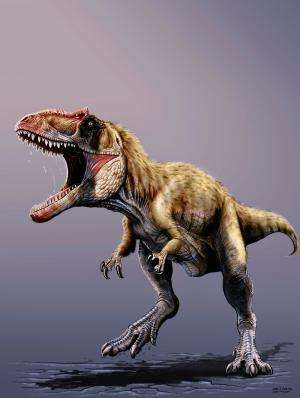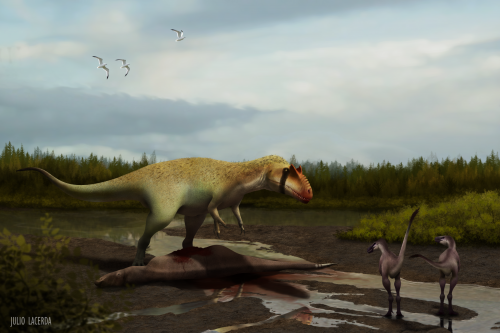Colossal new predatory dino terrorized early tyrannosaurs

A new species of carnivorous dinosaur – one of the three largest ever discovered in North America – lived alongside and competed with small-bodied tyrannosaurs 98 million years ago. This newly discovered species, Siats meekerorum, (pronounced see-atch) was the apex predator of its time, and kept tyrannosaurs from assuming top predator roles for millions of years.
Named after a cannibalistic man-eating monster from Ute tribal legend, Siats is a species of carcharodontosaur, a group of giant meat-eaters that includes some of the largest predatory dinosaurs ever discovered. The only other carcharodontosaur known from North America is Acrocanthosaurus, which roamed eastern North America more than 10 million years earlier. Siats is only the second carcharodontosaur ever discovered in North America; Acrocanthosaurus, discovered in 1950, was the first.
"It's been 63 years since a predator of this size has been named from North America," says Lindsay Zanno, a North Carolina State University paleontologist with a joint appointment at the North Carolina Museum of Natural Sciences, and lead author of a Nature Communications paper describing the find. "You can't imagine how thrilled we were to see the bones of this behemoth poking out of the hillside."
Zanno and colleague Peter Makovicky, from Chicago's Field Museum of Natural History, discovered the partial skeleton of the new predator in Utah's Cedar Mountain Formation in 2008. The species name acknowledges the Meeker family for its support of early career paleontologists at the Field Museum, including Zanno.

The recovered specimen belonged to an individual that would have been more than 30 feet long and weighed at least four tons. Despite its giant size, these bones are from a juvenile. Zanno and Makovicky theorize that an adult Siats might have reached the size of Acrocanthosaurus, meaning the two species vie for the second largest predator ever discovered in North America. Tyrannosaurus rex, which holds first place, came along 30 million years later and weighed in at more than twice that amount.
Although Siats and Acrocanthosaurus are both carcharodontosaurs, they belong to different sub-groups. Siats is a member of Neovenatoridae, a more slender-bodied group of carcharodontosaurs. Neovenatorids have been found in Europe, South America, China, Japan and Australia. However, this is the first time a neovenatorid has ever been found in North America.
Siats terrorized what is now Utah during the Late Cretaceous period (100 million years ago to 66 million years ago). It was previously unknown who the top meat-eater was in North America during this period. "Carcharodontosaurs reigned for much longer in North America than we expected," says Zanno. In fact, Siats fills a gap of more than 30 million years in the fossil record, during which time the top predator role changed hands from carcharodontosaurs in the Early Cretaceous to tyrannosaurs in the Late Cretaceous.
The lack of fossils left paleontologists unsure about when this change happened and if tyrannosaurs outcompeted carcharodontosaurs, or were simply able to assume apex predator roles following carcharodontosaur extinction. It is now clear that Siats' large size would have prevented smaller tyrannosaurs from taking their place atop the food chain.
"The huge size difference certainly suggests that tyrannosaurs were held in check by carcharodontosaurs, and only evolved into enormous apex predators after the carcharodontosaurs disappeared," says Makovicky. Zanno adds, "Contemporary tyrannosaurs would have been no more than a nuisance to Siats, like jackals at a lion kill. It wasn't until carcharodontosaurs bowed out that the stage could be set for the evolution of T. rex."
At the time Siats reigned, the landscape was lush, with abundant vegetation and water supporting a variety of plant-eating dinosaurs, turtles, crocodiles, and giant lungfish. Other predators inhabited this ecosystem, including early tyrannosaurs and several species of other feathered dinosaurs that have yet to be described by the team. "We have made more exciting discoveries including two new species of dinosaur," Makovicky says.
"Stay tuned," adds Zanno. "There are a lot more cool critters where Siats came from."
More information: "Neovenatorid theropods are apex predators in the Late Cretaceous of North America" Nov. 22, 2013 in Nature Communications
Abstract
Allosauroid theropods were a diverse and widespread radiation of Jurassic-Cretaceous megapredators. Achieving some of the largest body sizes among theropod dinosaurs, these colossal hunters dominated terrestrial ecosystems until a faunal turnover redefined apex predator guild occupancy during the final 20 million years of the Cretaceous. Here we describe a giant new species of allosauroid—Siats meekerorum gen. et sp. nov.—providing the first evidence for the cosmopolitan clade Neovenatoridae in North America. Siats is the youngest allosauroid yet discovered from the continent and demonstrates that the clade endured there into the Late Cretaceous. The discovery provides new evidence for ecologic sympatry of large allosauroids and small-bodied tyrannosauroids. These data support the hypothesis that extinction of Allosauroidea in terrestrial ecosystems of North America permitted ecological release of tyrannosauroids, which went on to dominate end Cretaceous food webs.
Journal information: Nature Communications
Provided by North Carolina State University





















